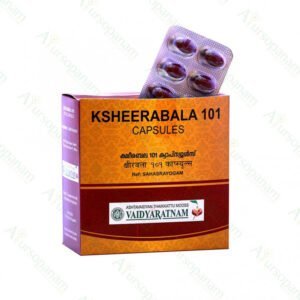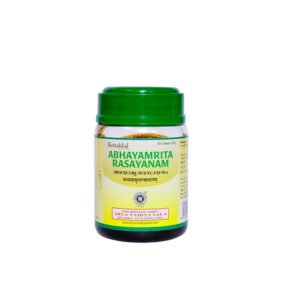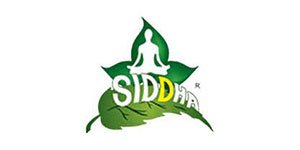Mahatiktaka Ghrita is a balancing combination of ‘Pitta-samana’ drugs in a nourishing ghee base. Ayurvedic materia medica lists groups of drugs based on their ‘rasa’ or taste. Drugs dominant in ‘Tikta rasa’ or bitter taste act upon deranged Pitta and ‘digest’ it. This maybe understood as the resolution of inflammatory changes in the gut as well as skin, bones, joints and supporting tissue.
‘Ghrita’ or medicated ghee harnesses the healing properties of herbs and roots in a nourishing fat base. Ayurveda attributes ‘sookshma’ property to ghrita, i.e. It is capable of reaching deep into tissues, and heals from within. It is perfectly suitable for long term use in sustaining the effects of treatment in a body and preventing relapse.
Features & Benefits
- Mahatiktaka Ghrita is a balancing blend of Tikta rasa (bitter taste) and Seeta veerya (cooling nature) drugs that pacifies deranged ‘pitta dosha’ in the system.
- Deranged Pitta dosha vitiates ‘rakta’ (blood), heats up the body, interrupts metabolic pathways and causes up build up of endotoxins (ama), which manifests as chronic skin diseases and inflammatory changes in the gut.
- Mahatiktaka Ghrita pacifies the excess heat and acidity caused by this deranged Pitta in the gut and bowel. It relieves sour belching, acid eructation and indigestion.
- It improves skin health and immunity. It heals chronic lesions, with or without discharge, rashes and urticaria.
- Lifestyle diseases are invariably rooted in inflammation throughout the system. Mahatiktaka Ghrita breaks down inflammatory pathways and restores metabolism.
Dosage and Instructions
Adult: 7-10 ml Mahatiktaka Ghrita early in the morning on empty stomach.Child: 5-7 ml Mahatiktaka Ghrita once in the morning on empty stomach.
Key Ingredients
Sapthaparna (Alstoniascholaris)
Scientifically known as Alstoniascholaris, it is widely used in skin disorders and intestinal worm infestation.
Parpataka (Fumaria Indica)
It is scientifically known as Fumaria indica. in Charaka and Sushruta, parpata is recommended for treatment of fevers and blood disorders. in Sushruta, the plant has also been recommended in case of chronic skin diseases, urinary diseases and cough.
Aragvadha (Cassia Fistula)
It is scientifically known as Cassia fistula. Aragvadha is a Sanskrit word, means which eliminate the disease. It is used as a medicine in Ayurveda, Siddha and Unani system of medicine. in Ayurveda it is mainly indicated in Skin diseases and as a mild laxative in children.
Vacha (Acorus calamus)
Scientifically known as Acorus calamus, Vacha is an ancient herb having various health benefits. The name “Vacha” in Sanskrit means speaking clearly because this herb stimulates intelligence and expression. in Ayurveda, Vacha is known as a rejuvenating herb because of its effect on the nervous system. It is bitter in taste and is used in the dried form. According to Ayurveda, taking Vacha along with honey on a daily basis helps manage speech disorders due to its Vata balancing and Medhya properties.
Harithaki (Terminalia Chebula)
It is scientifically known as Terminalia chebula. Indian gooseberry is most commonly use in high cholesterol abnormal levels of cholesterol or blood fats (dyslipidemia), and persistent heartburn It is also used for diarrhoea , nausea, and cancer, but there is no good scientific evidence to support these uses.
Vibithaki (Terminalia Bellerica)
Scientifically known as Terminalia bellerica, it is one among the Triphala. Baheda is beneficial in relieving cough and cold symptoms due to its antimicrobial and anti-allergic properties. Taking Baheda powder along with honey helps relieve cough as it improves immune health. Bahedachurna is an effective home remedy to improve digestion. Baheda powder helps in weight loss as it improves metabolism and reduces ‘Ama’ by increasing the digestive fire.
Amalaki (Embelica Officinalis)
Scientifically known as Embelica officinalis, Amalaki is commonly used to promote longevity in Ayurveda. It is also used by Ayurvedic practitioners to improve the health of the blood, bones, digestive system, liver, and skin.
Patha (Cyclea Peltate)
Scientifically known as Cyclea peltate, it is widely used in bone fracture and wound healing. It is also used in the treatment of fever and act as a breast milk purifier.
Haridra (Curcuma longa)
Scientifically known as Curcuma longa, it is widely used in many of the cosmetic drugs that have wide action on skin, and allergy.
Daru Haridra (Berberis Aristate)
Scientifically known as Berberis aristate, Daruharidra is mainly beneficial for skin problems like inflammation and psoriasis as it has anti-inflammatory and anti-psoriatic activity. It helps in managing acne by preventing the growth of acne causing bacteria and reducing inflammation due to its antibacterial and anti-inflammatory properties.
Pippali (Pipper Longum)
Scientifically known as Pipper longum. Pippali is an effective home remedy in managing cough and cold. Swallowing Pippali powder along with honey after lunch and dinner helps release mucus from the air passages due to its expectorant property, thus allowing the patient to breathe easily. It’s consumption might also help promote weight loss by improving the body’s metabolism. Consuming Pippali powder might be useful in managing constipation by promoting bowel movements due to its laxative property.
Vasa(Adathodavasica)
Scientifically known as Adathodavasica, vasapowder along with honey is considered to be beneficial in cases of respiratory infections such as whooping cough, bronchitis, asthma as it helps promote the secretion of sputum from the air passages due to its expectorant property. vasamight also help manage the symptoms of arthritis due to its antioxidant and anti-inflammatory properties. It reduces joint pain and swelling associated with arthritis and gout. It also reduces cramps due to its antispasmodic property.
Mustha (Cyperus rotundus)
Scientifically known as Cyperus rotundus, Mustha helps improve digestion due to its Deepan and Pachan properties, if taken in the recommended dosage. Mustha oil is an effective home remedy for managing stomach disorders due to its antispasmodic and carminative properties.
















































Ratings & Customer Reviews
Reviews
There are no reviews yet.